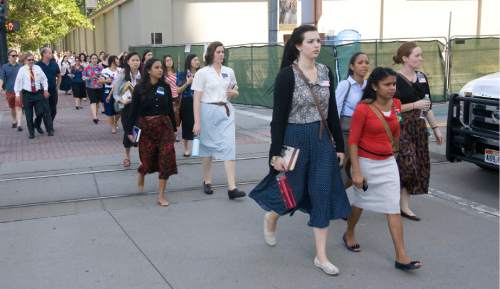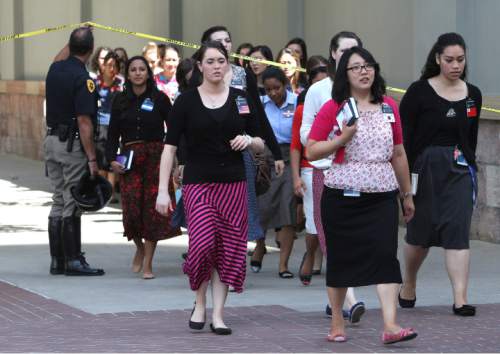This is an archived article that was published on sltrib.com in 2016, and information in the article may be outdated. It is provided only for personal research purposes and may not be reprinted.
Utah's birthrate dipped to a historic low in 2014, continuing a downward trend that began during the Great Recession, new state data show.
The decline mirrors a national trend, but new figures from the U.S. Centers for Disease Control and Prevention show Utah's decrease is more pronounced since birthrates reached a peak in 2007 — a phenomenon that may be an outgrowth of a change in the age of Mormon missionary service.
Nationally, the birthrate slipped to 12.5 births per 1,000 people in 2014. That's a 13 percent drop from the peak in 2007. In Utah, the birthrate fell to 17.4 births per 1,000 people in 2014. That's an 18 percent decline from the peak in 2007.
Utah still has the nation's highest birthrate, largely driven by a population base rooted in a predominant Mormon culture that encourages larger families.
Pam Perlich, director of demographic research and the University of Utah's Kem C. Gardner Policy Institute, said Wednesday it seems people are waiting longer to get married and have kids because a shortage of good-paying jobs deprive them of the economic security they want before starting families.
"This is tied up in this terrible recession we've had," Perlich said. "People have not formed households. They've continued to live with their parents. They've put off marriage. They're putting off childbearing."
The nearly 51,200 babies born in Utah in 2014 marked a significant decline from a peak of 55,600 in 2008, according to data from the Utah Department of Health.
The recession exacerbated a longer-term societal trend of people waiting longer to start having kids and choosing to form smaller families, Perlich said. On this front, Utah has lagged behind the rest of the nation, according to data from the U.S. Census analyzed by Perlich's organization.
Nationally, the average family size decreased to 3.26 people in 2014, down 11 percent from 3.65 in 1960. In Utah, however, the average family size dropped to 3.65 people in 2014, down 9 percent from 3.99 in 1960.
Perlich said she doesn't know exactly why Utah's birthrate is declining faster than the national figure, but it may have something to do with the October 2012 decision by The Church of Jesus Christ of Latter-day Saints to reduce the minimum age for female missionaries to 19 from 21.
That led to a historic influx of women serving missions and may be prompting them to wait longer to get married and start families, Perlich said. Women serve 18 months on proselyting missions around the world.
Perlich said that it will require several more years of data to be able to properly analyze the impact.
"It's a natural experiment. We're going to watch and see what happens," said Perlich, adding, "The imprint of that policy change could be being seen in this data."
More than half of Utah's nearly 3 million residents are estimated to be active Mormons.
While young LDS men have always been expected to serve missions, traditionally there's been less of an expectation for women, with many choosing to marry and start families before reaching the previously required age of 21.
Even before that rule change, there was evidence that Mormon couples were following a national trend of having smaller families. Whereas LDS families two generations ago often had four to six kids, Perlich said, this new generation is often choosing to have two or three.
Perlich expects Utah's birthrate to rebound when the latest waves of young adults begin having children as the economy improves.
But, she said, the overall decline is a significant, legitimate trend that policymakers in Utah are largely ignoring because they get fixated on the fact that the state has the country's highest birthrate.
"We have more kids than other states on average, but it's come way down," Perlich said. "People are operating with an obsolete view of fertility rates in Utah."









